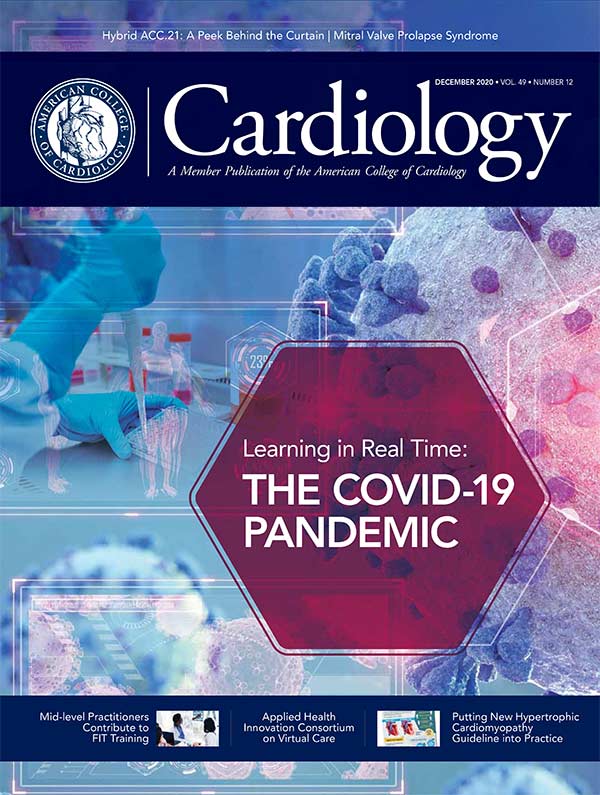Putting the New ACC/AHA Hypertrophic Cardiomyopathy Guideline Into Practice

The ACC and the American Heart Association (AHA) have released an updated guideline for managing patients with hypertrophic cardiomyopathy (HCM). The guideline encourages shared decision-making between the clinician and patient as essential when determining the course of treatment, and updates recommendations for sudden cardiac death (SCD) risk assessment and HCM center referrals based on the latest evidence.
The 2020 AHA/ACC Guideline for the Diagnosis and Treatment of Patients with Hypertrophic Cardiomyopathy, published in the Journal of the American College of Cardiology, updates the previous guideline issued in 2011.
The guideline offers recommendations on the evaluation and management of patients with HCM and is geared to cardiovascular and noncardiovascular clinicians.
New recommendations reflect recent evidence about diagnostic modalities such as electrocardiography, imaging and genetic testing; management of patients including medical therapies, septal reduction therapies and SCD risk assessment/prevention; and other considerations such as participation in activities/sports, occupation and pregnancy.

The updated guideline also clarifies the various treatments, which may include medications such as a beta-blocker and/or a calcium channel blocker, a surgical procedure and/or a device like an ICD.
Different from the 2011 guideline, the updated guideline emphasizes shared decision-making in the management of HCM to personalize treatment options based on the patient's goals and concerns.
"Shared decision-making, a dialogue between patients and their care team that includes full disclosure of all testing and treatment options, discussion of the risks and benefits of those options and, importantly, engagement of the patient to express their own goals, is particularly relevant in the management of conditions such as hypertrophic cardiomyopathy," said Steve R. Ommen, MD, FACC, chair of the writing committee. "This updated guideline places emphasis on including the patient in the decision-making process rather than simply providing dogmatic lists of do's and don'ts."
While the guideline writers recognize that patients with HCM can be evaluated and treated by a cardiovascular care team, recommendations are made for patients with severe HCM, or those facing complex decisions, to be referred to multidisciplinary HCM centers to receive optimal care.

Guidance around participation in healthy physical activity is also updated to make it clearer that recreational exercise is an option for patients with HCM. According to the updated guideline, participation in competitive sports may also now be considered in selected patients after a complete discussion between patients with HCM and their doctors about the potential risks.
"Increasingly, data affirm that the beneficial effects of exercise on general health can be extended to patients with HCM," Ommen said. "Healthy recreational exercise (moderate intensity) has not been associated with increased risk of ventricular arrhythmia events in recent studies."
Furthering the personalized approach to care, the guideline also includes updated recommendations for assessing individual risk markers for SCD, which can help identify patients who may need an ICD, and counseling patients about the potential genetic transmission of HCM and screening options for family members.
Key Perspectives: 2020 AHA/ACC Guideline For HCM

Shared decision-making is recommended for all aspects of HCM care including genetic testing, activity, lifestyle and therapy choices.

Referral to an HCM center of excellence should be considered to address complex management decisions.

Initial diagnostic evaluation for all HCM patients should include a comprehensive physical exam with a three-generation family history. Clinical features associated with HCM phenocopies should be assessed.

An initial electrocardiogram (ECG) and 24- to 48-hour ambulatory ECG monitoring are recommended followed by surveillance ECG every 1-2 years. For palpitations or lightheadedness, extended monitoring is recommended, which should only be considered diagnostic if symptoms occurred while monitoring.

For all patients with suspected HCM, a transthoracic echocardiogram (TTE) is recommended. If resting left ventricular outflow tract (LVOT) gradient is <50 mm Hg, provocative testing should be performed. For symptomatic patients without provoked gradients, an exercise echocardiogram should be performed. For clinically stable HCM patients, surveillance echocardiograms should be considered every 1-2 years to assess for changes in extent of hypertrophy, obstruction and cardiac function.

Cardiac magnetic resonance imaging should be obtained in HCM patients when echocardiography is inconclusive, if there is a suspicion for an alternative diagnosis (like infiltrative/storage diseases), for SCD risk stratification, and may be needed for selection and planning of septal reduction therapy.

For HCM patients with symptoms of myocardial ischemia, computed tomography (CT) or invasive coronary angiography should be considered. Prior to surgical myectomy, invasive or CT angiography should be obtained. For patients who are candidates for septal reduction therapy but there is uncertainty regarding presence of LVOT obstruction on noninvasive studies, invasive hemodynamic assessment is recommended.

Genetic testing should be offered to HCM patients to elucidate the genetic basis and to allow for family screening. Pre- and post-testing genetic counseling is recommended for individuals undergoing genetic testing. For HCM patients with genetic variants of uncertain significance, serial re-evaluation of test results is recommended to assess for variant reclassification, as this may trigger testing for family members. Preconception and prenatal reproductive and genetic counseling should also be offered.

In first-degree relatives of patients with HCM, clinical screening should include ECG and TTE during the initial evaluation followed by periodic follow-up according to their age (1-2 years in adolescents, 3-5 years in adults) or if clinical status changes. If the proband has a pathogenic or likely pathogenic variant on genetic testing, cascade genetic testing should be offered. For relatives who test negative on cascade genetic test, additional clinical screening is not recommended.

For HCM patients with cardiac arrest or sustained ventricular tachycardia (VT), single-chamber transvenous or subcutaneous ICD implantation is recommended as a Class I recommendation. As a Class IIa recommendation, it is reasonable to offer an ICD for patients with massive LV hypertrophy ≥30 mm, history of suspected cardiac syncope, LV apical aneurysm, systolic dysfunction with ejection fraction (EF) <50%, or family history of sudden cardiac death due to HCM. For patients without these risk factors, ICDs should not be implanted, especially for the sole purpose of participation in competitive athletics.

For symptomatic HCM patients with LVOT obstruction, nonvasodilating beta-blockers (BBs) are recommended. If BBs are ineffective or not tolerated, verapamil or diltiazem are recommended. Verapamil and diltiazem are contraindicated in case of hypotension, severe dyspnea at rest, children <6 weeks old, and for resting gradients over 100 mm Hg. For symptoms refractory to all these agents, disopyramide may be added or septal reduction therapy may be offered at high-volume centers. If surgical septal reduction is contraindicated, alcohol septal ablation can be considered at experienced centers.

For symptomatic patients with nonobstructive HCM and preserved LVEF, BBs, verapamil or diltiazem are recommended.

For patients with HCM and clinical atrial fibrillation (AFib), anticoagulation is recommended, irrespective of CHA2DS2-VASc score, with direct-acting oral anticoagulants as first-line therapy followed by warfarin. For HCM patients with subclinical AFib, anticoagulation is recommended if AFib lasts >24 hours.

For HCM patients with VT or recurrent ICD shocks despite BB use, antiarrhythmic therapy with amiodarone, mexiletine, sotalol or dofetilide may be considered. If VT remains refractory to antiarrhythmics, heart transplant evaluation should be considered.

For HCM patients who develop systolic dysfunction with EF <50%, coronary artery disease should be ruled out and guideline-directed therapy for heart failure with reduced EF should be initiated. For patients with NYHA class III-IV symptoms, a cardiopulmonary stress test should be considered to quantify functional limitation and help with decision-making regarding advanced heart failure therapies.

For HCM patients participating in athletics, comprehensive evaluation and shared decision-making regarding risk of participating in sports is recommended. For most HCM patients, mild to moderate, recreational, noncompetitive exercise for the purpose of leisure is beneficial.

For pregnant HCM patients, BBs should be continued with monitoring of fetal growth and care should be coordinated between cardiology and obstetrics. If anticoagulation is indicated for AFib or other reasons, low molecular weight heparin or warfarin (if maximum dose <5 mg daily) are recommended.
Clinical Topics: Arrhythmias and Clinical EP, Cardiovascular Care Team, Diabetes and Cardiometabolic Disease, Heart Failure and Cardiomyopathies, Prevention, Implantable Devices, SCD/Ventricular Arrhythmias, Atrial Fibrillation/Supraventricular Arrhythmias, Exercise
Keywords: ACC Publications, Cardiology Magazine, American Heart Association, Calcium Channel Blockers, Decision Making, Disclosure, Goals, Death, Sudden, Cardiac, Cardiomyopathy, Hypertrophic, Electrocardiography, Risk Assessment, Arrhythmias, Cardiac, Exercise, Genetic Testing, Writing, Occupations
< Back to Listings

